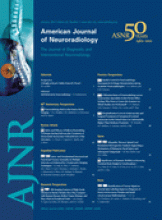We thank Drs Sarikaya and McKinney for their response to our article entitled “The Relation of Carotid Calcium Volume with Carotid Artery Stenosis in Symptomatic Patients”1 and would hereby like to respond to some of their very meaningful discussion points.
We certainly agree that there is a large difference in the definition of the domain between our study and the 2 studies performed by their group.2,3 In our study, we have correlated the calcium volume with the degree of stenosis of the carotid artery in a population of high-risk patients with recent neurologic symptoms. In the studies of Sarikaya et al3 and McKinney et al,2 the relation between carotid artery stenosis and calcium volume was investigated in a more “general” patient population.
The difference in patient population follows from the different objectives. Sarikaya et al3 and McKinney et al2 investigated the role of calcium volume in screening patients at risk, whereas our study explored the possibility of using calcium volume to identify stenoses of >70%. In current clinical practice, the degree of stenosis of the internal carotid artery is used in the decision to perform carotid endarterectomy, because it is the strongest predictor of its effect.4,5 With such a difference in objectives and in patient domain, it is actually not surprising to observe a spectrum effect.6 However, the extent of this effect was beyond our expectations.
The second issue that was addressed by Sarikaya and McKinney is that in our article, we presented the diagnostic accuracy for thresholds different from the optimal value reported in their articles, 0.06 cm3. We actually used a whole range of thresholds, including 0.06 cm3, as presented in the receiver operating characteristic analysis curve (Fig 3 in our article). This curve shows that for all thresholds, the diagnostic accuracy is rather poor. We presented the diagnostic accuracy for 0.03 and 0.09 cm3 to illustrate the outer ends of the range of sensitivity and specificity of the calcium volume−based stenosis detection for our patient population. However, a direct comparison would benefit from the presentation of the values for the 0.06-cm3 threshold.
We acknowledge Sarikaya and McKinney for observing the weak correlation of calcium volume and the degree of stenosis of the carotid artery on the unaffected side, as opposed to the absence of such a correlation on the affected side. This suggests a stronger correlation of calcium volume and degree of stenosis in asymptomatic patients or arteries. We also thought this was a puzzling finding. Hypothetically, it may express a relation of plaque composition and potential neurologic symptoms. Actually, we have performed a study in the same patient population in which we correlated the intracranial calcium volume burden with intracranial stenosis, which we hope to publish soon. In this study, we actually confirmed the correlation of calcium volume and stenosis in the intracranial arteries. We agree with Sarikaya and McKinney that the role of carotid artery calcium volume and its relation with various neurologic symptoms requires additional research effort.
References
- © 2012 by American Journal of Neuroradiology







